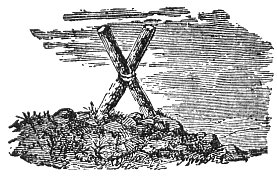of confession and baptism, and a future life of happiness or misery. He celebrated the Oblation of bread, image of the resurrection. The baptism of newly-born children, extreme unction, confession of sins,–all belonged to the Mithriac rites. The candidate was purified by a species of baptism, a mark was impressed upon his forehead, he offered bread and water, pronouncing certain mysterious words.
During the persecutions in the early ages of Christianity, the Christians took refuge in the vast catacombs which stretched for miles in every direction under the city of Rome, and are supposed to have been of Etruscan origin. There, amid labyrinthine windings, deep caverns, hidden chambers, chapels, and tombs, the persecuted fugitives found refuge, and there they performed the ceremonies of the Mysteries.
The Basilideans, a sect of Christians that arose soon after the time of the Apostles, practised the Mysteries, with the old Egyptian legend. They symbolized Osiris by the Sun, Isis by the Moon, and Typhon by Scorpio; and wore crystals bearing these emblems, as amulets or talismans to protect them from danger; upon which were also a brilliant star and the serpent. They were copied from the talismans of Persia and Arabia, and given to every candidate at his initiation.
Irenæus tells us that the Simonians, one of the earliest sects of the Gnostics, had a Priesthood of the Mysteries.
Tertullian tells us that the Valentinians, the most celebrated of all the Gnostic schools, imitated, or rather perverted, the Mysteries of Eleusis. Irenæus informs us, in several curious chapters, of the Mysteries practised by the Marcosians; and Origen gives much information as to the Mysteries of the Ophites; and there is no doubt that all the Gnostic sects had Mysteries and an initiation. They all claimed to possess a secret doctrine, coming to them directly from Jesus Christ, different from that of the Gospels and Epistles, and superior to those communications, which in their eyes, were merely exoteric. This secret doctrine they did not communicate to every one; and among the extensive sect of the Basilideans hardly one in a thousand knew it, as we learn from Irenæus. We know the name of only the highest class of their Initiates. They were styled Elect or Elus [Ἐκλεκτοί] Strangers to the World and [ξένοι ἐν κόσμῳ]. They had at least three Degrees–the Material, the Intellectual, and the Spiritual, and the lesser and greater Mysteries; and the number of those who attained the highest Degree was quite small.
Footnotes
568:1 The Substance, or Very Self, of which the Alohayim are the manifestations.
Next: Prince of Mercy, or Scottish Trinitarian Part 2

Moe is the founder of GnosticWarrior.com. He is a father, husband, author, martial arts black belt, and an expert in Gnosticism, the occult, and esotericism.





